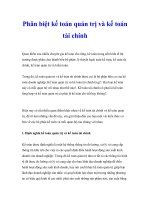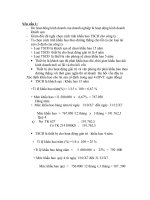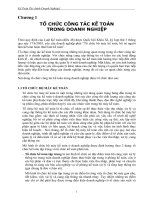tiểu luận kế toán tài chính management fraud and accounting tips are used to manipulate enrons income statement and balance sheet
Bạn đang xem bản rút gọn của tài liệu. Xem và tải ngay bản đầy đủ của tài liệu tại đây (71.11 KB, 11 trang )
I. INTRODUCTION TO ENRON AND ITS FRAUD
1. General introduction to Enron
Enron Group was established in 1985 on the basis of merging two companies,
Houston Natural Gas and Internorth of Omaha.In 1985, Kenneth Lay merged Houston
Natural Gas and InterNorth to found Enron Energy Company. In the early 1990s, Lay
contributed to selling electricity at market prices, so traders like Enron could sell energy
at a higher price and significantly increase the profit.Thanks to the new regulations on
liberalizing the US energy market in the 1990s, they built from a blurring company into a
corporation that could change the balance in the energy business.
By 1992, Enron had grown to become the largest natural gas dealer in North
America. In November 1999, the company launched EnronOnline trading website to
better manage contracts trading business. In an effort to achieve further growth, Enron
has pursued a strategy of diversification.Enron owns and operates a wide range of assets
including gas pipelines, power plants, pulp and paper plants, water plants, along with a
wide range of services worldwide. Enron also earns additional revenue by buying and
selling contracts within the same array of products and services that the company
participates in.
Enron stock prices soared, from the early 1990s to the end of 1998 jumped 311%,
outperforming the growth rate of the S&P 500 index. In the 2 years of the millennium
hinge, Enron stock prices increased by 56% and 87%, while the S&P index increased by
20% in 1999 and decreased by 10% in 2000. Enron continued to be a bright star on the
stock market.
On December 31, 2000, Enron shares were priced at US $ 83.13 / share and the
company's market capitalization exceeded US $ 60 billion, 70 times higher than its
income and 6 times the book value, indicating the stock market. much expectation on
Enron's future prospects. In addition, Enron has been evaluated for 6 consecutive years
by the Fortune Magazine survey as "America's most innovative company".
In August 2001, CEO Jeffrey Skilling resigned for personal reasons. Enron
announced a loss of 618 million USD in the third quarter but actually reached 1.2 billion
USD.
2. Enron's cheating situation
Enron has committed fraudulent activity to make fraudulent financial statements.
Enron is a listed company on the stock market, the company prepares fraudulent
financial statements to adjust to "beauty" Financial statements: beautify business results,
beautify the balance sheet, theory Intelligent financial statements omit important
information. It was the misinformation about management ability, Enron was advertised
very effectively through the audit firm Arthur Andersen and Wall Street analysts, so the
number of people buying the company's shares is record high.
When the company was in trouble, they persuaded workers to receive salaries and
bonuses in stock. When the US Securities and Exchange Commission investigated,
Fastow's CFO had to leave, Enron's stock plummeted, the trust of lost customers no
longer invested. This is the basis of suspicion that caused the incident. exposed. The debt
of USD 1.2 billion is hidden
The Arthur Branch of Arthur Andersen issued false audit reports to benefit Enron, so
getting 1 million USD / week also involved finding partners for Enron. The huge amount
of money overshadowed the audit staff and they were easy to ignore the principle. CEO
Arthur Andersen, Mr. Joe Berardino admitted they had violated a serious mistake to do
everything to limit it. lowest of Enron's ability to break, but they destroyed most
documents related to the incident.
To hide the fact that the company had borrowed through its affordability, Enron's
leader took advantage of the legal loophole to set up subsidiaries without financial
statements. In this way, Enron did not have to publicize the debts, and concealed losses.
Enron's results inflated its profits and the company's stock price also increased
accordingly.
When Enron officially announced in 1997 that the company had lost over $ 500
million, insiders promptly collected huge profits from company stocks. Specifically, the
Chairman and General Director held 138 million shares of the company. In early 2001,
Ken sold for $ 79 a share and these deals were not published. In late 2001, the stock price
was only $ 0.6.
Enron's financial activities were all based on the design and operation of the name
"Ghostly Alliance". A network of interconnected ties between Enron, a number of
government officials and especially auditor Arthur Andersen. Interesting point Arthur
Andersen signed a contract to advise Enron. After that, I played an audit role to confirm
Enron's financial statements.
II. ANALYSIS OF ENROL’S FRAUD CASE
1. COMPLETE PROCEDURES IN
ENRON
FINANCIAL
STATEMENTS
a. Fraudulent acts of the Board of Directors
The Board of Directors is responsible for: Directly responsible for preventing and
detecting fraud while Enron's Board of Directors are the ones who seek and implement
accounting frauds to achieve the item. my destination.
With a rapid growth strategy, Enron's Board of Directors actively buys other
companies and assets. A large part of the loan from the bank, a part of the capital issued
by the company to buy Enron partner company shares with the level of Enron's
leadership did not stand in the field of energy production and trading but jumped into the
financial services sector in the energy sector. This is a risky business and requires a lot of
capital. The monopoly in the management and control of the company, the management
of the company decides to produce at a higher level than the optimal capacity. This
allows the company to reduce the price of the product unit by taking advantage fixed
costs, thereby increasing the current year's profit.
The downside of this work is that machinery and equipment must work with higher
capacity than the optimal, negatively affecting the productivity and durability of the
device. At the same time, products that make a lot of unsold items will incur storage
costs. Long-term inventory leads to a decrease in value, these costs will directly affect the
company's profitability in the following years. Or cut down on research and development
costs, advertising costs, equipment maintenance costs.
As a provider, Enron signed price fixing contracts with future customers and
collected fees from these contracts. These costs are included in the current revenue, while
the risks are in Enron's future will incur subsidiaries founded by Enron to name the
property, and suffer and isolate financial risks.
For example: When Enron develops more pipes, the company can set up a subsidiary
(SPE). This SPE unit will own the pipeline and immediately mortgage this pipeline and
take the revenue from the pipeline to pay the creditor. In this way, the balance sheet of the
company does not represent the whole property. corresponding debt
SPE-related accounting law: According to accounting regulations, in the total capital
of the subsidiary, there must be at least 3% of Enron's shares. But if Enron's shares are
less than 50% of SPE's stock, Enron's books do not represent TS and the debt liability of
SPE. At the time of the collapse, Enron has 900 SPE, most of them are located in tax
preferential countries. Enron uses SPE to manipulate financial statements, hiding
investors from information that should have been disclosed. Although there is very little
equity, SPE can still borrow from banks for two reasons:
* First: Creditors believe that Enron has signed a contract to use SPE's assets so
SPE's activities are guaranteed.
* Second: they believe Enron bailed out for SPE loans
Enron's debt: Enron has created a legal trick in which Enron, SPE and JP-Morgan
have used the way of swapping contracts to make long-term debt shown on the balance
sheet as "stock responsibilities." "
Exaggerate sales and profits: Enron sells assets to SPEs with inflated prices to create
fake profits. The company also buys and sells with SPE to increase sales and reduce the
level of fluctuation of profits.
Covering losses: Even in the third quarter of 2001, the company only reported losses,
but the losses actually arise from previous years. Especially in the fuel crisis in 2000,
when the world fuel prices were high, Enron still had to sell at fixed prices according to
the signed contracts. The company used contract tricks to convert these losses into SPEs.
However, when the SPE lost, the value of Enron's shares in SPE fell below the minimum
3% required. Consolidating SPE's financial situation and parent company's financial
statements caused two effects: the parent company's debt increased and the parent
company's profit dropped.
Fraud of senior managers takes place throughout the company. Many executives
benefit. A lot of Enron Energy Management's managers are involved in accounting fraud,
illegal internal transactions. Among them, Enron's CEO Andrew Fastow has illegally
benefited over 33 million. The USD from the loopholes of transactions helps the directors
to earn profit here is the fee for buying shares of the members at a very high level and the
monopoly in the management of the company. In early 2001, Ken sold out for $ 79 a
share. Most of these purchases were not published. In late 2001, the stock price was only
$ 0.6. Non-transparent accounting procedures mask the loss of the group by establishing
outside cover companies.
The financial statements are not transparent, high stock prices mean high
expectations of the company about the profitability of the company, thereby putting
pressure on leaders to create corresponding profits. On the other hand, leaders also hold a
large number of stocks, so they themselves do not want stock prices to decline.
b. Fraud in accounting of Enron company
Revenue Fraud: Prices in the energy industry fluctuate very strongly, while
customers need to stabilize prices. As a provider, Enron signed price fixing contracts with
future customers and charged them. These charges are included in the current revenue,
while the future risk of Enron will be incurred.
Investment: With a rapid growth strategy, Enron actively bought more companies
and other assets. A large part of the loan from the bank. Part of the capital issued by the
company is the option to buy shares of the company. The release of options increases the
motivation for evaluating the company with a more positive outlook.
Use of prepaid contracts:Enron borrows banks but does not properly recognize the
liabilities, but recognizes it as "future energy business transaction". In particular, the loan
amount is recorded as sales revenue, interest is recorded as a risk of price risk. Enron
borrowed about 8.6 billion, but did not declare it as a debt on the financial statements.
Misuse of fair value method: Enron takes advantage of the permission to apply a fair
value method to evaluate higher than the real value of assets without market prices or
difficult to identify; or to estimate interest on investment projects and record interest
immediately even though the project is not yet active; or record revenue and profit right
after signing long-term future contracts.
Create special-purpose units (SPE): Enron's Board of Directors established many
businesses. Each business only performs a certain purpose. These businesses are "tools"
to perform complex transactions to cover up the real financial situation and create virtual
profits for Enron, and are the basis for performing misappropriation of assets. It is
important that the financial statements of SPEs are not incorporated into Enron's financial
statements.
The companies, called SPE (Special Purpose Entity), were founded by Enron to name
their assets and suffer and isolate financial risks. For example, when Enron developed
more pipes, the company could create a SPE. This SPE unit will own the pipeline and
mortgage this pipe to borrow money to build. Enron can still use this pipeline and take
revenue from the pipeline to pay the creditor. In this way, the company's balance sheet
does not represent both assets (pipeline) and debt liability respectively.
SPE-related accounting law: According to the accounting rules, the total capital of
the subsidiary must be at least 3% of Enron's shares. But if Enron's shares were below
50% of SPE's stock, Enron's books did not represent SPE's assets and liabilities.
Abuse of SPE: Although the number of SPEs has increased over the years, experts
say a company with four or five such partners is too much. At the time of the collapse,
Enron had 900 SPE, most of which were located in tax-free or easy-to-access countries.
Enron uses these SPE to manipulate financial statements, hiding investors from
information that should have been disclosed, and exploiting differences in financial
accounting laws as well as tax accounting laws.
Debts of subsidiaries: Although for only very little equity, the SPE can borrow from
banks for two reasons. First, creditors believe that Enron has signed a contract to use
SPE's assets, so SPE's operations are guaranteed. Secondly, they believe Enron bailed out
for SPE's loans.
Debt of Enron: Enron himself borrowed to expand, but a company could not borrow
too much due to limited creditors' terms. Enron has invented a legal trick in which Enron,
SPE, and JP-Morgan have used conversion contracts to make long-term debt shown on
the balance sheet as "stock liability".
2. CONSEQUENCES AND SOLUTION
a. Consequences
With the above tips, the company profits were inflated and thereby helped the
company's stock price rise. Part of the capital issued by the company is the option to buy
shares of the company. The release of options increases the motivation for evaluating the
company with a more positive outlook. This deceives investors and employees of the
corporation (when paying by shares). At that time, stock trading and stock options
brought huge profits to the key managers of Enron (the Liar).
For the market and society: The collapse of Enron has caused strong influence on
society in general and audit profession in particular. This incident has lost the confidence
of investors in the stock market as well as the quality of auditing. AA provided Enron
audit and consulting services for 16 years and their revenue in 2000 was 52 million from
Enron. Independence occurs when revenue from Enron accounts for a large proportion of
AA's total revenue. Enron had to file for bankruptcy in late 2011, becoming the largest
US bankruptcy until that time with a whopping 63.4 billion dollars. Their 85,000
employees become unemployed.
b. Solutions
1. Enron's accounting frauds were compared to some of the weaknesses in accounting
standards at the time. Firstly, due to unclear provisions on conditions for SPE companies,
it is necessary to consolidate financial statements with the parent company. Secondly, it is
allowed to evaluate investments according to fair value instead of original prices without
specific and uniform regulations, thus creating an opportunity for Enron to inflate its
assets and profits as well as to hide losses. company losses.
2. Violations of key managers at Enron mainly stem from weaknesses in the control
system of the company. The Board of Directors and the Supervisory Board cannot fulfill
their supervisory functions with the board of directors. The senior executives of the
corporation violated business ethics when they sought to inflate profits with high salaries.
3. The collapse of Enron helped narrow the gaps of accounting standards as well as
the legal provisions on readability of auditors, and professional organizations also
renewed the rules on religion. German career. In addition, the Saxbanes - Oxley Act of
2002 asked the US Securities and Exchange Commission (SEC) to establish an
independent monitoring organization (PCAOB) and further strengthen its role in security.
protect investors.
III.REFERENCES
1. />2. />3. />4. />5. />









